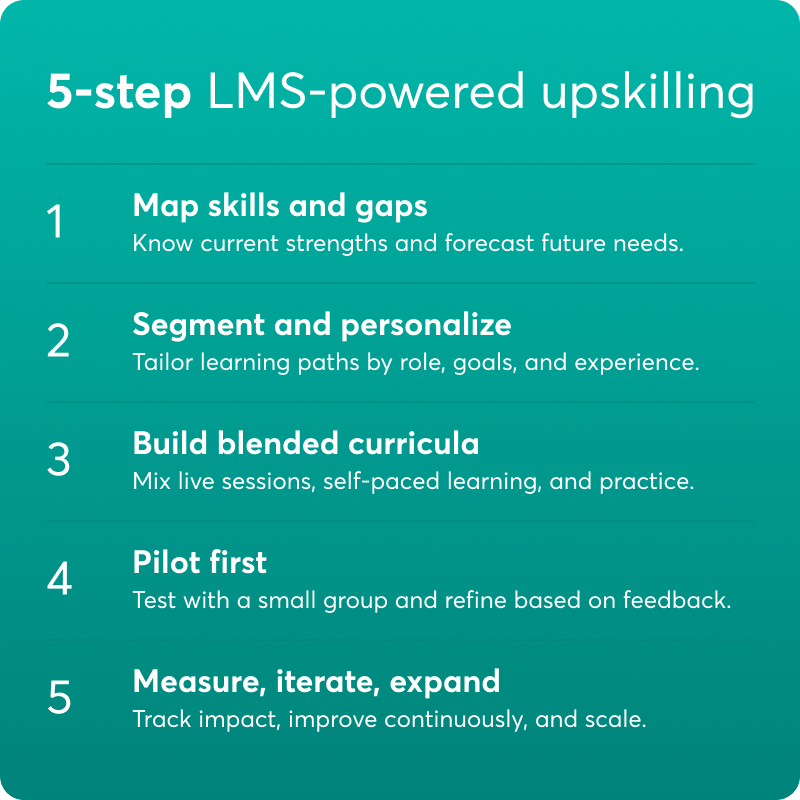Table of Contents
When it comes to business, you are only as good as your people. What does this mean? You can have the most ambitious and well-thought-out business strategy and still fail if your workforce doesn’t have the skills to realize it.
That’s why upskilling and reskilling employees is quintessential. Maybe now more than ever, with AI shifting the desired skill sets overnight.
According to LinkedIn’s Workplace Report 2025 [1], organizations that prioritize career development outperform other businesses on multiple positive indicators. The most important ones include the ability to attract and retain the top talent in the job market, and to be at the forefront of AI adoption.
So the question is, do you want to lead? Or do you want to follow?
This blog post explains everything you need to know about employee upskilling, including:
What is employee upskilling?
Employee upskilling refers to employees deepening and expanding existing skills rather than cultivating new skills.
The term refers to technical skills, which vary wildly:
It also refers to soft skills, like:
Often confused with upskilling, reskilling refers to obtaining new skills rather than improving existing ones. Think about a web developer who starts learning a new programming language—that’s upskilling. But if they take a course on graphic design, that’s reskilling.
According to the Future of Jobs report 2025 [2],
Limitations of traditional upskilling methods
There are many ways to help employees develop new skills and broaden their career paths, but some traditional methods have clear drawbacks and get in the way of building a culture of continuous learning. Let’s see why traditional approaches often fall short.
Instructor-led training
Instructor-led training (ILT) refers to training delivered by an instructor in real time. While it is an excellent way to interact and engage with learners, it also comes with significant disadvantages that make it an unrealistic option for continuous development.
Stand-alone course libraries
Course libraries offer self-paced, off-the-shelf courses on a variety of topics. While they offer a wide range of options and flexibility, they are ultimately not effective for employee development:
Talent marketplaces
Talent marketplaces are platforms within an organization that match employees to internal upskilling opportunities based on their interests and career progression goals. They are designed to promote internal mobility and help employees grow new skills through a hands-on approach.
Although real-world application is a plus, talent marketplaces are ultimately quite limiting:
Why an LMS is the best upskilling platform
A Learning Management System (LMS) brings everything you need for upskilling into one place and helps you shape tailored career paths for every employee. Here’s why it’s such a good choice for building relevant skills across your organization:
Centralized skills inventory and gap analysis
Features like skills mapping, skills intelligence tools, surveys, and employee assessments enable you to see exactly what skills your workforce has, where the gaps are, and who needs what training. Fostering a continuous learning culture becomes easy when you know where your needs lie.
Personalized learning paths
Not every employee needs the same content; different job roles, level of experience, and even learning preferences must be taken into account. A good LMS allows you to offer different types of content, AI-driven learning paths, segment learners based on your desired criteria, and drip-feed content to ensure maximum knowledge retention.
Microlearning
Long courses can feel overwhelming. Microlearning breaks training into bite‑sized lessons that are easier to fit into the day and much easier to remember. It can be all the more helpful for new employees who have so much new information to obtain.
Mobile access
Your people aren’t tied to their desks, so your learning shouldn’t be either. With a dedicated mobile app, employees can learn anytime, anywhere and enjoy a seamless learning experience.
Engagement features
The best LMS platforms keep learners coming back with features like gamification, social learning communities, and digital certifications that reward progress and celebrate achievements.
Analytics & ROI dashboards
With an LMS, you’ll always know what’s working. Track usage data, see completion rates, and even correlate training with performance metrics to prove the impact of your upskilling efforts.
The table below sums up what LMSs and traditional methods offer in terms of cost, engagement, and tracking:
Our platform, LearnWorlds, is a top-rated AI-powered LMS that combines ease of use, advanced learning features, deep reporting, and so much more that you simply need to see for yourself.
Sign up for your 30-day free trial now.
5-step LMS-powered upskilling rollout

In the sake of keeping things simple, we have created a simple 5-step plan for you to follow when using an LMS for upskilling.
Step 1: Inventory current skills & map future gaps
You can’t design training programs without first knowing where your organization stands. What skills do your employees already have? Where are the skills gaps that hinder their career development and very likely your business success?
There’s more than one way to measure skills gaps:
Prevention is better than cure, though, so don’t stop at current gaps. Look ahead to anticipate future needs and business priorities to inform and shape your reskilling initiatives today.
You don’t need any magical powers for this—just sound strategic planning. Evaluate your current situation and review your business roadmap to forecast which roles and skills will be critical. By doing this, you will build a strong internal talent pool and promote within your current employees.
Step 2: Personalize by segmenting learners
Personalization is key to offering the most suitable development opportunities and increasing not only productivity but also employee engagement. Start by segmenting learners based on role, department, seniority, experience level, and career goals, as these have been discussed in advance with their managers or mentors. This segmentation allows you to assign training paths that resonate with each employee, instead of offering one-size-fits-all content.
Step 3: Build blended curricula
The best upskilling programs combine synchronous (live) and asynchronous (self‑paced) learning elements, and whenever possible, hands‑on practice with an expert for more advanced skills.
Key benefits of blended learning:
Step 4: Launch pilots to gather feedback
Before rolling out your upskilling program company-wide, make it available to a small group of employees to collect feedback, especially if this is your first upskilling and reskilling attempt. Doing so will help you gauge employee sentiment toward the program: Is it relevant enough? Is it engaging? What can be improved?
Step 5: Measure impact, iterate, expand
Collecting employee feedback is even more important at the end of every upskilling program. Send out employee surveys or embed them in your LMS at the end of the course or even specific lessons.
Measuring the impact on the job is essential for your organization’s success. Key upskilling metrics include job performance and productivity. In the long run, you should also see an impact on job satisfaction and employee retention, especially if you have established a continuous learning culture.
Another way to measure the impact of your upskilling program is by monitoring performance and how employees have responded to it. Check data like completion rates, number of certificates issued, and time spent on individual activities.
👉LearnWorlds offers an advanced report system enhanced with conversational AI for faster access to insights. The reports can be customized and some can additionally be scheduled. The Training and Activity Matrixes give you a bird’s eye view of what’s going on in your training academy, from overall course performance and training status to individual learner progress and engagement.

Overcoming barriers to your upskilling strategy
There are three common barriers to upskilling and reskilling programs: time, budget, and adoption. Let’s see how you can move past them and effectively support the career development of your employees and instill a culture of lifelong learning.
Time
Time constraints are a common challenge standing in the way of workforce development. These can concern both the time you need to design and roll out a program, but also the limited time available for training on the part of your employees despite the best intentions from both sides.
From your part:
See how we saved time building our own academy, with the help of AI:
From your employees’ perspective:
Budget
Budget constraints are often one of the biggest challenges when rolling out upskilling initiatives. The good news is that there are smart ways to make the most of your resources without sacrificing the quality of your training programs:
👉 See some of the best affordable LMS solutions here.
Adoption
Even the best upskilling strategy can fail if employees don’t actually use the learning resources available to them. Adoption barriers often stem from a lack of awareness and insufficient motivation, and of course when the program doesn’t cultivate skills employees find relevant.
Need help choosing an LMS? Read our ebook “The 5 non-negotiables when choosing your LMS” to see which features should not miss from your LMS no matter what type of training you want to build.
Upskilling is the new competitive advantage
Make no mistake. Ongoing upskilling (and reskilling where necessary) is the single best way to keep up with technological advances, support your employees’ career growth, and sustain a successful business.
In this blog post, we’ve shared essential strategies to help you empower employees and hone new skills that are vital. Before you go, sign up for a 30-day free trial with LearnWorlds, the LMS that will help you bring it all to life.
References:

Androniki Koumadoraki
Androniki is a Content Writer at LearnWorlds sharing Instructional Design and marketing tips. With solid experience in B2B writing and technical translation, she is passionate about learning and spreading knowledge. She is also an aspiring yogi, a book nerd, and a talented transponster.
FAQ
Everything you have ever wondered, but were too afraid to ask...




